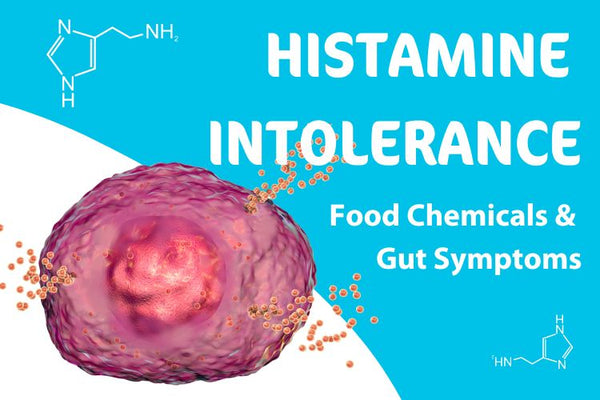- Ph: +61 435 003 412
- operations@fodshopper.com.au
"Organic Orange" has been added to your cart. View cart
"Organic Orange" has been added to your cart. View cart

Histamine is a molecule stored in the immune cells of the body. Its role is to stimulate gastric acid secretion, inflammation, smooth muscle dilation & contraction, among other processes. (1, 2).
Histamine is responsible for some major functions in the body:
• Communicating messages to the brain.
• Triggers the release of acid in the stomach to assist digestion.
• Released after an allergic reaction or injury as part of the immune response.
Histamine intolerance is not a sensitivity to histamine, rather it is when too much histamine has accumulated in the body.
When histamine levels get too high or when it can’t be broken down completely, normal bodily functions may be affected.
Histamine intolerance is a sensitivity to dietary histamine, whereby the body has an impaired ability to metabolize ingested histamine found in a range of common foods. (1)
This intolerance presents when there is impaired diamine oxidase (DAO) enzyme activity, resulting in reduced histamine degradation in the small intestine. This results in histamine accumulation in the body, resulting in undesirable symptoms.
Low blood levels of the DAO enzyme has been linked to functional gastrointestinal disorders (FGID), such as IBS.
Foods containing high levels of histamine include:
1. Processed fish and meat i.e. cured, canned and dry fermented sausages e.g. salami.
2. Dairy products i.e. raw milk cheeses, pasteurized milk cheese, etc.. In which the fermenting bacteria also have aminogenic (potential to produce an immune response) behaviour.
3. Alcoholic beverages such as red wine.
Others may also include:
• Pickled or canned foods: Sauerkraut, pickles, relishes, soy sauce
• Fruit: Dried fruit, strawberries, citrus
• Vegetables: Tomatoes and tomato products, spinach
• Legumes: Chickpeas, soybeans, peanuts
• Chocolate
• Grains: Wheat
• Histamine releasers: Citrus, papaya, pineapple, nuts, strawberries, egg white, additives
• DAO blockers: alcohol, black and green tea
Consumption of histamine-rich foods or beverages which trigger the release of histamine, or impair DAO activity, may cause the below symptoms:
Flushing (2)
There are currently no proven tests to diagnose histamine intolerance. While it may be a cause of symptoms, it is important to also investigate related disorders such as mast cell disorders, true allergies, Inflammatory Bowel Disease (IBD), Coeliac Disease (CD), fructose malabsorption, Small Intestinal Bacterial Overgrowth (SIBO) or others. (1-3)
Once the above-mentioned disorders have been investigated, a histamine elimination diet may be trialled with an Accredited Practising Dietitian (APD).
If symptoms improve when histamine is lowered or eliminated from the diet, histamine intolerance may be present.
An improvement in the above-mentioned symptoms can be achieved with a histamine-reduced diet (HRD). (3)
Consuming a HRD that is low in the food products outlined above (products of microbial fermentation, such as aged cheese, wine, sauerkraut, and processed meat etc..) and low in the foods listed below may be helpful. (4, 5)
Alternatively, consider using an antihistamine in consultation with your pharmacist.
Oils: Most cooking oils (5).
Histamine intolerance is challenging to diagnose due to lack of proven testing methods. Other conditions must be first investigated and ruled out before a histamine elimination diet is implemented.
Requesting a referral from a doctor to see an Accredited Practising Dietitian to assist in ascertaining dietary sources of histamine and tolerance thresholds related to symptom onset is of value.
1. Comas-Baste et al. (2020). Histamine Intolerance: The Current State of the Art. Biomolecules. 2020 Aug; 10(8): 1181. Published online 2020 Aug 14. doi: 10.3390/biom10081181.
2. Maintz & Novak (2007). Histamine and histamine intolerance. The American Journal of Clinical Nutrition, Volume 85, Issue 5, May 2007, Pages 1185–1196, https://doi.org/10.1093/ajcn/85.5.1185.
3. Lackner et al (2019). Histamine-reduced diet and increase of serum diamine oxidase correlating to diet compliance in histamine intolerance. European Journal of Clinical Nutrition, Volume 73, Pages 102–104.
4. Halász et al. (1994). Biogenic amines and their production by microorganisms in food. Trends Food Sci Technol. 5:42-9.
5. Amy Burkhart (2023). Histamine Intolerance: Symptoms, Diet & Treatment: https://theceliacmd.com/histamine-intolerance-symptoms-diet-treatment/#:~:text=There%20are%20currently%20no%20proven,seem%20to%20correlate%20with%20symptoms.

Leave a reply